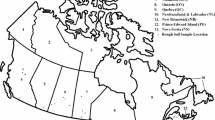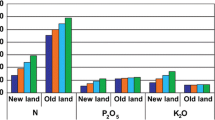Abstract
The paper reveals the experimental procedure and thermo-physical characteristics of a coarse pyroclastic soil (Pozzolana), from the neighborhoods of Rome, Italy. The tested samples are comprised of 70.7 % sand, 25.9 % silt, and 3.4 % clay. Their mineral composition contained 38 % pyroxene, 33 % analcime, 20 % leucite, 6 % illite/muscovite, 3 % magnetite, and no quartz content was noted. The effective thermal conductivity of minerals was assessed to be about \(2.14\,\hbox {W}{\cdot } \hbox {m}^{-1}{\cdot } \hbox {K}^{-1}\). A transient thermal probe method was applied to measure the thermal conductivity (\(\lambda \)) over a full range of the degree of saturation \((S_{\mathrm{r}})\), at two porosities (n) of 0.44 and 0.50, and at room temperature of about \(25\,^{\circ }\hbox {C}\). The \(\lambda \) data obtained were consistent between tests and showed an increasing trend with increasing \(S_{\mathrm{r}}\) and decreasing n. At full saturation (\(S_{\mathrm{r}}=1\)), a nearly quintuple \(\lambda \) increase was observed with respect to full dryness (\(S_{\mathrm{r}}=0\)). In general, the measured data closely followed the natural trend of \(\lambda \) versus \(S_{\mathrm{r}}\) exhibited by published data at room temperature for other unsaturated soils and sands. The measured \(\lambda \) data had an average root-mean-squared error (RMSE) of \(0.007\,\hbox {W}{\cdot } \hbox {m}^{-1}{\cdot } \hbox {K}^{-1}\) and \(0.008\,\hbox {W}{\cdot } \hbox {m}^{-1}{\cdot } \hbox {K}^{-1}\) for n of 0.50 and 0.44, respectively, as well as an average relative standard deviation of the mean at the 95 % confidence level \((\hbox {RSDM}_{0.95})\) of 2.21 % and 2.72 % for n of 0.50 and 0.44, respectively.





Similar content being viewed by others
References
V.R. Tarnawski, T. Momose, W.H. Leong, G. Bovesecchi, P. Coppa, Int. J. Thermophys. 30, 949 (2009)
E. Cattoni, M. Cecconi, V. Pane, Bull. Eng. Geol. Environ. 66, 403 (2007)
P. De Vita, A. C. Angrisani, E. Di Clemente, Ital. J. Eng. Geol. Environ. 2, 5 (2008)
M. Cecconi, M. Scaparazzi, G.M.B. Viggiani, Bull. Eng. Geol Environ. 69, 185 (2010)
G. Bovesecchi, P. Coppa, Int. J. Thermophys. 34, 1962 (2013)
S. Sanchez-Moral, L. Luque, J.-C. Canaveras, V. Soler, J. Garciaguinea, A. Aparicio, Lime Pozzolana mortars in Roman Catacombs: composition, structures and restoration. Cem. Concr. Res. 35, 1555 (2005)
P.H. Cochran, L. Boersma, C.T. Youngberg, Thermal properties of a pumice soil. SSSAJ 31, 454 (1967)
E. Ashworth, The variation of the thermal conductivity of tuff with moisture. experimental results and proposed model. in Proceedings of 33rd U.S. Symposium on Rock Mechanics, ed. by J.R. Tillerson, W.R. Wawersik. Santa Fe, New Mexico (1992)
Y. Yamazaki, F. Tsuchiya, O. Tsuji, Trans. JSIRRE 226, 497 (2003)
J. Schönenberger, T. Momose, B. Wagner, W.H. Leong, V. R. Tarnawski, Int. J. Thermophys. 33, 342 (2012)
Ki-iti Horai, Thermal conductivity of rock forming minerals. J. Geophys. Res. 76, 1278–1308 (1971)
F. Brigaud, G. Vasseur, Mineralogy, porosity and fluid control on thermal conductivity of sedimentary rocks. Geophys. J. 98, 525–542 (1989)
C. Clauser, E. Huenges, Thermal conductivity of rocks and minerals, in Rock Physics and Phase Relations: A Handbook of Physical Constants, American Geophysical Union, vol. 3, ed. by T.J. Ahrens (American Geophysical Union, Washington, DC, 1995), p. 105
O. Johansen, Thermal conductivity of soils. Ph.D. thesis, Trondheim, Norway 1975. (CRREL Draft Translation 637, 1977). ADA 044002
B.R. Blake, K.H. Hartge, Particle density, in ASA Monograph No 9, Part 1, ed. by A. Klute (1906)
V.R. Tarnawski, M. L. McCombie, T. Momose, I. Sakaguchi, W.H. Leong, Int. J. Thermophys. 34, 1130 (2013)
V.R. Tarnawski, T. Momose, W.H. Leong, Int. J. Thermophys. 32, 984 (2011)
L. Kirkup, R.B. Frenkel, An Introduction to Uncertainty in Measurement Using the GUM Guide to the Uncertainty in Measurement (Cambridge University Press, Cambridge, 2006)
D.A. De Vries, in Thermal Properties of Soils, ed. by W.R. van Wijk (North-Holland, Amsterdam, 1963)
F. Gori, On the theoretical prediction of the effective thermal conductivity of bricks. in Proceedings of the 8th International Heat Transfer Conference, II (1986)
S. Lu, T. Ren, Y. Gong, R. Horton, An improved model for predicting soil thermal conductivity from water content at room temperature. Soil Sci. Soc. Am. 71, 8 (2007)
V. Tarnawski, T. Momose, W. H. Leong, B.Wagner, Performance evaluation of soil thermal conductivity models, in Proceedings of ASME-ATI-UIT Conference on Thermal and Environmental Issues in Energy Systems, Sorrento, Italy (2010)
V.R. Tarnawski, F. Gori, Int. J. Energy Res. 26, 143 (2002)
F. Gori, S. Corasaniti, Detection of a dry-frozen boundary inside Martian regolith. Planet. Space Sci. 56, 1093 (2008)
F. Gori, S. Corasaniti, New model to evaluate the effective thermal conductivity of three-phase soils. Int. Commun. Heat Mass Transf. 47, 1 (2013)
F. Gori, S. Corasaniti, Effective thermal conductivity of three-phase soils. in Proceedings of The ASME International Mechanical Engineering Congress and Exposition 2012, Fluid and Heat Transfer, Houston, Texas, USA, vol 7 Part D, p. 2369 (2012)
Acknowledgements
The authors wish to express sincere gratitude to Bavarian Environment Agency (Hoff, Germany), for conducting XRD/XRF analyses. Additionally, sincere thanks are due to Prof. G. Viggiani and M. Scaparazzi for their assistance in collecting Pozzolana samples. Finally, the authors would like to thank Mr. Owen Brown from Bedford Institute of Oceanography (Canada) for carrying out the textural analysis of the tested Pozzolana sample.
Author information
Authors and Affiliations
Corresponding author
Appendix: \({\varDelta } T\) Versus ln(t) Trend for Tested Pozzolana Samples
Appendix: \({\varDelta } T\) Versus ln(t) Trend for Tested Pozzolana Samples
See Fig. 6.
Rights and permissions
About this article
Cite this article
McCombie, M.L., Tarnawski, V.R., Bovesecchi, G. et al. Thermal Conductivity of Pyroclastic Soil (Pozzolana) from the Environs of Rome. Int J Thermophys 38, 21 (2017). https://doi.org/10.1007/s10765-016-2161-y
Received:
Accepted:
Published:
DOI: https://doi.org/10.1007/s10765-016-2161-y





